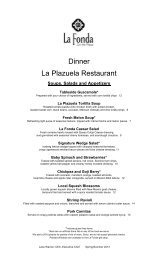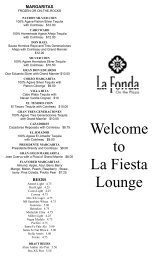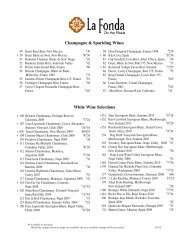in every room a story of the art in every room a ... - La Fonda Hotel
in every room a story of the art in every room a ... - La Fonda Hotel
in every room a story of the art in every room a ... - La Fonda Hotel
Create successful ePaper yourself
Turn your PDF publications into a flip-book with our unique Google optimized e-Paper software.
Willard Clark’s<br />
woodcuts graced<br />
<strong>every</strong>th<strong>in</strong>g from<br />
menus to “Do Not<br />
Disturb” signs.<br />
been design<strong>in</strong>g hotels and <strong>in</strong>teriors for <strong>the</strong> company and <strong>the</strong> AT&SF Railway s<strong>in</strong>ce<br />
1902, worked closely with Meem and is responsible for many <strong>of</strong> <strong>the</strong> decorative<br />
elements so loved by visitors today.<br />
Colter attended <strong>the</strong> California School <strong>of</strong> Design <strong>in</strong> San Francisco. Her four<br />
build<strong>in</strong>gs at <strong>the</strong> Grand Canyon (Hermit’s Rest, Desert View Watchtower,<br />
Lookout Studio, and Hopi House) which were built for <strong>the</strong> Fred Harvey<br />
Company, were declared National Historic <strong>La</strong>ndmarks <strong>in</strong> 1987. She also<br />
designed <strong>the</strong> Bright Angel Lodge located at <strong>the</strong> South Rim <strong>of</strong> <strong>the</strong> canyon. The<br />
vernacular build<strong>in</strong>gs look as if <strong>the</strong>y have always been p<strong>art</strong> <strong>of</strong> <strong>the</strong> landscape.<br />
In <strong>the</strong> book From Every W<strong>in</strong>dow: A Glimpse <strong>of</strong> <strong>the</strong> Past, chronicl<strong>in</strong>g <strong>the</strong> hi<strong>story</strong> <strong>of</strong><br />
<strong>La</strong> <strong>Fonda</strong>, Barbara J. Harrelson notes that Colter brought her <strong>in</strong>terest <strong>in</strong> work<strong>in</strong>g<br />
with local <strong>art</strong>ists and craftspeople to <strong>the</strong> project <strong>in</strong> Santa Fe as well. “Special touches<br />
<strong>in</strong>clude hand-crafted chandeliers, t<strong>in</strong> and copper light<strong>in</strong>g fixtures, and colorful<br />
tiles and textiles,” Harrelson writes. “Hand-carved, hand pa<strong>in</strong>ted furniture and<br />
o<strong>the</strong>r ornamentation by local <strong>art</strong>ists add <strong>in</strong>dividual character and charm.”<br />
6 7<br />
When William Haskell Simpson became <strong>the</strong> general advertis<strong>in</strong>g agent <strong>of</strong> <strong>the</strong> AT&SF Railway <strong>in</strong> 1900, he had an idea: commission<br />
<strong>art</strong>ists from <strong>the</strong> East to pa<strong>in</strong>t <strong>the</strong> landscape and people <strong>of</strong> <strong>the</strong> West and use <strong>the</strong>ir work to promote travel to <strong>the</strong> area. In 1907 <strong>the</strong> railway<br />
put out its first calendar featur<strong>in</strong>g a Southwestern-<strong>the</strong>med pa<strong>in</strong>t<strong>in</strong>g. The tradition cont<strong>in</strong>ued until 1993, and <strong>the</strong> calendars have<br />
become collectors’ items. Orig<strong>in</strong>al <strong>art</strong> and quality reproductions have been used to promote <strong>the</strong> Southwest for over 100 years, draw<strong>in</strong>g<br />
tourists and <strong>art</strong>ists to <strong>the</strong> region and creat<strong>in</strong>g one <strong>of</strong> <strong>the</strong> most important <strong>art</strong> economies <strong>in</strong> <strong>the</strong> country.<br />
The AT&SF Railway commissioned Gerald Cassidy (1879–1934) to create pa<strong>in</strong>t<strong>in</strong>gs that could be reproduced to promote travel to <strong>the</strong><br />
Southwest <strong>in</strong> railroad stations across <strong>the</strong> country. Eleven <strong>of</strong> Cassidy’s commissioned pa<strong>in</strong>t<strong>in</strong>gs—recently restored to <strong>the</strong>ir orig<strong>in</strong>al<br />
colorful brilliance—hang throughout <strong>the</strong> hotel. The Fred Harvey Company commissioned o<strong>the</strong>r <strong>art</strong>ists <strong>in</strong>clud<strong>in</strong>g Olive Rush,<br />
Paul <strong>La</strong>ntz, Arnold Rönnebeck, and Willard Clark, whose woodcuts graced <strong>every</strong>th<strong>in</strong>g from menus to “Do Not Disturb” signs.<br />
<strong>La</strong>ter, <strong>art</strong> by Native American <strong>art</strong>ists such as Harrison Begay, Julian M<strong>art</strong><strong>in</strong>ez, Tomás Vigil, and Romando Vigil entered <strong>the</strong> collection.<br />
The hotel’s dist<strong>in</strong>ctive appearance is attributed to its architect Isaac Rapp (1854–1933), who had developed a style that was an idiosyncratic<br />
blend <strong>of</strong> Spanish, Pueblo, and Moorish elements. John Gaw Meem (1894–1983), <strong>the</strong> pr<strong>in</strong>cipal developer <strong>of</strong> <strong>the</strong> Pueblo Revival style,<br />
was hired by <strong>the</strong> Fred Harvey Company to design a significant addition to <strong>La</strong> <strong>Fonda</strong> <strong>in</strong> 1926. Mary Jane Colter (1869–1958), who had<br />
Willard Clark<br />
Woodcut<br />
ca. 1930s<br />
In 1976 <strong>La</strong> <strong>Fonda</strong>’s orig<strong>in</strong>al courtyard was enclosed to create <strong>the</strong> restaurant,<br />
<strong>La</strong> Plazuela, designed by architect William Lumpk<strong>in</strong>s (1909–2000). A 2009 renovation<br />
<strong>of</strong> <strong>the</strong> space by architect Barbara Felix and <strong>in</strong>terior designer Dierdre Wilson<br />
followed Mary Jane Colter’s orig<strong>in</strong>al ideas and <strong>in</strong>volved collaboration with local<br />
craftsmen just as Colter had done.<br />
The creation and renovation <strong>of</strong> <strong>La</strong> Plazuela recreates an atmosphere that is similar<br />
to <strong>the</strong> ambience <strong>of</strong> <strong>the</strong> hotel’s early days. The <strong>story</strong> <strong>of</strong> <strong>the</strong> <strong>art</strong> and <strong>the</strong> <strong>story</strong> <strong>of</strong> <strong>the</strong><br />
<strong>art</strong>ists are p<strong>art</strong> <strong>of</strong> <strong>La</strong> <strong>Fonda</strong>’s liv<strong>in</strong>g hi<strong>story</strong>.





